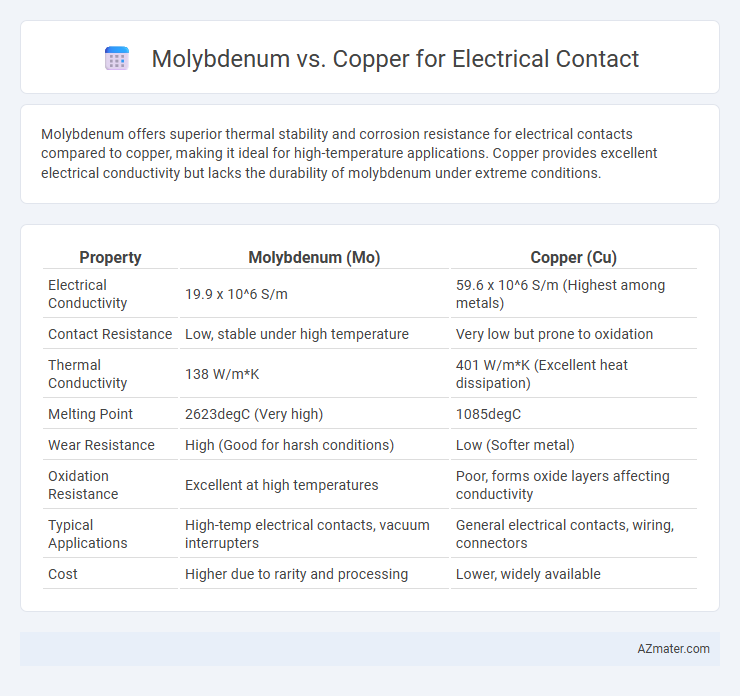Molybdenum offers superior thermal stability and corrosion resistance for electrical contacts compared to copper, making it ideal for high-temperature applications. Copper provides excellent electrical conductivity but lacks the durability of molybdenum under extreme conditions.
Table of Comparison
| Property | Molybdenum (Mo) | Copper (Cu) |
|---|---|---|
| Electrical Conductivity | 19.9 x 10^6 S/m | 59.6 x 10^6 S/m (Highest among metals) |
| Contact Resistance | Low, stable under high temperature | Very low but prone to oxidation |
| Thermal Conductivity | 138 W/m*K | 401 W/m*K (Excellent heat dissipation) |
| Melting Point | 2623degC (Very high) | 1085degC |
| Wear Resistance | High (Good for harsh conditions) | Low (Softer metal) |
| Oxidation Resistance | Excellent at high temperatures | Poor, forms oxide layers affecting conductivity |
| Typical Applications | High-temp electrical contacts, vacuum interrupters | General electrical contacts, wiring, connectors |
| Cost | Higher due to rarity and processing | Lower, widely available |
Introduction: Importance of Material Selection for Electrical Contacts
Material selection for electrical contacts is crucial to ensure optimal conductivity, durability, and resistance to wear and corrosion under operational conditions. Molybdenum and copper each offer distinct advantages: molybdenum provides excellent thermal stability and low thermal expansion, while copper excels in electrical conductivity but can suffer from surface oxidation. Choosing between molybdenum and copper impacts the efficiency, longevity, and reliability of electrical systems in industries such as aerospace, automotive, and power distribution.
Overview of Molybdenum and Copper
Molybdenum exhibits excellent electrical conductivity combined with high melting points, making it ideal for high-temperature electrical contacts and components exposed to harsh environments. Copper offers superior electrical and thermal conductivity with excellent ductility, making it the preferred material for most electrical contacts requiring efficient current flow at lower temperatures. The choice between molybdenum and copper depends on application-specific requirements such as thermal stability, conductivity, and mechanical strength.
Electrical Conductivity Comparison
Molybdenum exhibits electrical conductivity around 31.78 million siemens per meter (MS/m), while copper significantly outperforms with conductivity approximately 58 MS/m, making copper a preferred choice for electrical contacts requiring minimal resistance. Despite its lower conductivity, molybdenum offers superior thermal stability and resistance to oxidation, which benefits high-temperature applications where copper's performance diminishes. In summary, copper provides better electrical conductivity for contacts, but molybdenum's durability makes it advantageous in harsh environments.
Thermal Conductivity and Heat Resistance
Molybdenum exhibits superior heat resistance compared to copper, maintaining structural integrity at temperatures exceeding 2,600degC, making it ideal for high-temperature electrical contacts. Copper offers excellent thermal conductivity, around 400 W/m*K, facilitating efficient heat dissipation but suffers from lower melting point (1,085degC), which limits its performance in extreme heat environments. The balance between copper's thermal conductivity and molybdenum's heat resistance dictates their selection in electrical contacts subjected to varying thermal demands.
Mechanical Strength and Durability
Molybdenum offers superior mechanical strength and higher durability compared to copper, making it ideal for electrical contacts subjected to high stress and repetitive use. Its high melting point and resistance to wear contribute to longer service life in harsh environments. Copper, while excellent in electrical conductivity, tends to deform and wear faster under mechanical loads, reducing its durability in demanding applications.
Corrosion Resistance and Oxidation
Molybdenum exhibits superior corrosion resistance and oxidation stability compared to copper, making it ideal for harsh electrical contact environments. Copper, while highly conductive, oxidizes rapidly under high temperature and humid conditions, leading to increased contact resistance and potential failure. The dense oxide layer on molybdenum enhances its durability, ensuring consistent electrical performance in corrosion-prone applications.
Cost and Availability
Molybdenum offers higher cost efficiency compared to copper due to its greater durability and resistance to wear in electrical contacts, despite a higher initial price. Copper remains widely available and more affordable upfront, benefiting from extensive global mining and recycling infrastructure. The choice between molybdenum and copper depends on balancing long-term performance requirements with immediate budget and supply chain considerations.
Application Suitability: Where Each Material Excels
Molybdenum excels in high-temperature and high-current electrical contacts due to its superior thermal conductivity, low thermal expansion, and excellent resistance to arc erosion, making it ideal for vacuum interrupters and high-voltage switchgear. Copper offers exceptional electrical conductivity and is preferred in applications requiring low electrical resistance and efficient energy transfer, such as power distribution systems and electrical connectors. For environments with extreme thermal or mechanical stress, molybdenum provides enhanced durability, while copper's affordability and conductivity make it suitable for general-purpose electrical contacts.
Longevity and Maintenance Considerations
Molybdenum offers superior longevity in electrical contacts due to its excellent resistance to high temperatures and corrosion, reducing wear and the need for frequent replacements. Copper, while highly conductive, tends to oxidize and degrade faster under harsh electrical loads, increasing maintenance demands. Selecting molybdenum over copper optimizes durability and reduces maintenance intervals in high-performance electrical applications.
Conclusion: Choosing the Right Material for Electrical Contacts
Molybdenum offers superior wear resistance, high melting point, and excellent thermal stability, making it ideal for high-temperature electrical contacts in demanding environments. Copper excels in electrical conductivity and cost-effectiveness, suitable for general-purpose applications requiring efficient current flow. Selecting the right material depends on balancing electrical performance, environmental conditions, and mechanical durability specific to the application's requirements.

Infographic: Molybdenum vs Copper for Electrical Contact
 azmater.com
azmater.com